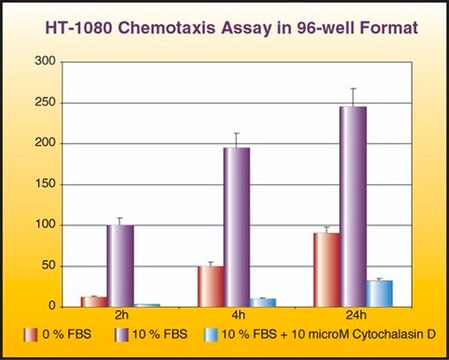ECM558
QCM Tumor Cell Transendothelial Migration Assay (Colorimetric, 24 Assays)
About This Item
Productos recomendados
fabricante / nombre comercial
Chemicon®
QCM
Nivel de calidad
técnicas
cell based assay: suitable
método de detección
colorimetric
Descripción general
Millipore′s QCM Tumor Cell Transendothelial Cell Migration Assay - Colorimetric provides an efficient model to analyze the ability of tumor cells to invade the endothelium. The assay is designed with an 8 μm pore size cell culture insert, appropriate for most cancer cell lines. The upper side of the cell culture insert is coated with fibronectin to support the optimal attachment and growth of endothelial cells. The assay allows investigators to compare the invasiveness of a variety of tumor cell lines, and to evaluate the effects of various factors influencing the process.
Precoated cell culture inserts are provided in the Millipore QCM Tumor Cell Transendothelial Cell Migration Assay to significantly reduce assay time. Additionally, the assay allows quantitative analysis of tumor cell migration. Following incubation of tumor cells with the endothelial cell layer, invasive tumor cells are stained and quantified. In a departure from traditional Boyden methodology, stain is eluted with extraction buffer, transferred to a microplate, and measured spectrophotometrically. (Prior to elution, the investigator has the option of counting cells individually, if desired.) Spectrophotometric absorbance correlates with cell migration.
Aplicación
Results of the assay may be illustrated graphically using a bar chart to display optical density (OD) values at ~570 nm.
A typical tumor cell transendothelial migration experiment will compare with a negative control. Negative control chambers, containing HUVECs only, function to determine the level of HUVECs migrating through the membrane. Cell migration in these chambers is generally low as there is no ECM on the lower side of the membrane to support endothelial migration, and these chambers are typically used as "blanks" for interpretation of data. As such, migration in test wells can be described as the value of tumor transendothelial migration minus the amount of migration visualized in the HUVEC only control.
Additional migration may also be induced or inhibited in test wells through the addition of cytokines or other pharmacological agents.
The following figures demonstrate typical migration results. One should use the data at left for reference only. This data should not be used to interpret actual assay results.
Apoptosis & Cancer
Envase
Componentes
2. TNFα: (Part No. 2004167) One tube - 20 μL at 0.1 mg/mL.
3. Cell Stain Solution*: (Part No. 20294) One vial - 10 mL
4. Extraction Buffer: (Part No. 20295) One vial - 10 mL
5. 24 well Stain Extraction Plate: (Part No. 2005871) One plate.
6. 96 well Stain Quantitation Plate: (Part No. 2005870) One plate.
7. Swabs: (Part No. 10202) 50 each.
8. Forceps: (Part No. 10203) 1 pair.
Almacenamiento y estabilidad
Información legal
Cláusula de descargo de responsabilidad
Palabra de señalización
Danger-Danger
Frases de peligro
Clasificaciones de peligro
Eye Irrit. 2 - Flam. Liq. 2
Código de clase de almacenamiento
3 - Flammable liquids
Clase de riesgo para el agua (WGK)
WGK 3
Certificados de análisis (COA)
Busque Certificados de análisis (COA) introduciendo el número de lote del producto. Los números de lote se encuentran en la etiqueta del producto después de las palabras «Lot» o «Batch»
¿Ya tiene este producto?
Encuentre la documentación para los productos que ha comprado recientemente en la Biblioteca de documentos.
Artículos
Cell based angiogenesis assays to analyze new blood vessel formation for applications of cancer research, tissue regeneration and vascular biology.
Nuestro equipo de científicos tiene experiencia en todas las áreas de investigación: Ciencias de la vida, Ciencia de los materiales, Síntesis química, Cromatografía, Analítica y muchas otras.
Póngase en contacto con el Servicio técnico





